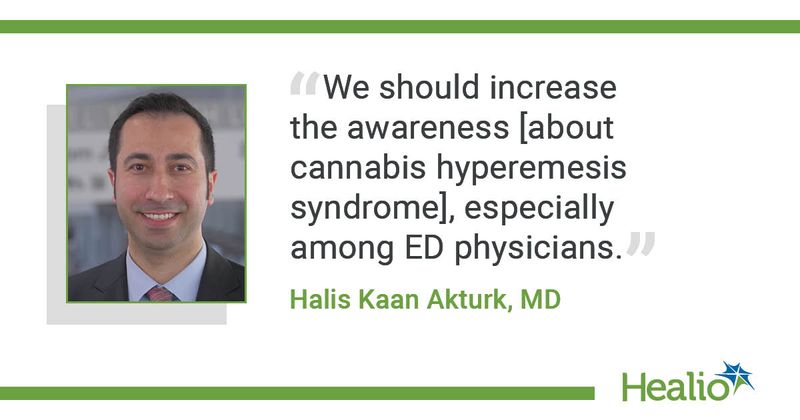Screen for cannabis hyperemesis syndrome for cannabis users with DKA symptoms
Key takeaways:
- Cannabis users with type 1 diabetes have a higher risk for DKA than nonusers.
- Providers should screen for cannabis hyperemesis syndrome when cannabis users present with DKA symptoms.
HOUSTON — People with type 1 diabetes who use cannabis and present at a hospital with diabetic ketoacidosis symptoms may have hyperglycemic ketosis related to cannabis hyperemesis syndrome, according to a speaker.
In a presentation at the Association of Diabetes Care and Education Specialists annual meeting, Halis Kaan Akturk, MD, associate professor of medicine and pediatrics at University of Colorado's Barbara Davis Center for Diabetes, said hyperglycemic ketosis related to cannabis hyperemesis syndrome is commonly misdiagnosed as diabetic ketoacidosis and gastrointestinal symptoms are contributed to diabetic gastroparesis among adults with type 1 diabetes and leads to patients being misdiagnosed and mistreated in hospitals. Akturk said measuring pH and bicarbonate levels can diagnose most cases of hyperglycemic ketosis related to cannabis hyperemesis syndrome, but providers must be aware and screen for this condition.

“We need more education,” Akturk said. “It’s not only for the patients, but also for the providers. We should increase the awareness, especially among ED physicians, primary care physicians and gastroenterologists.”
Cannabis use rising in U.S.
Akturk said raising awareness about hyperglycemic ketosis related to cannabis hyperemesis syndrome is critical with cannabis use growing in the U.S. In the presentation, Akturk said at least 40 states have legalized medical cannabis and 23 states have legalized recreational cannabis. Legalization has led to an increase in cannabis use as well as an increase in cannabis use disorder, according to Akturk.
Several studies have found an association between cannabis use and DKA. In a paper published in Diabetes Care in 2020, adults with type 1 diabetes attending centers participating in the T1D Exchange had a higher risk for DKA if they used cannabis compared with nonusers (OR = 2.5; 95% CI, 1-5.9). Another study published in the Canadian Journal of Addiction in 2019 found 37.6% of a group of cannabis users with type 1 diabetes had unhealthy cannabis use and 18% had possible cannabis use disorder.
“We are not trying to make cannabis bad,” Akturk said. “But for alcohol, we know you can get a DUI, if you drink too much you can develop cirrhosis or you can even die from alcohol intoxication. You can get addicted to it. But if the problem is cannabis, nobody thinks about [addiction]. Everyone thinks it is completely harmless, nothing happens, it never causes an addiction. It’s a misconception.”
Cannabis hyperemesis syndrome vs. DKA
Providers can use a set of criteria to differentiate DKA and cannabis hyperemesis syndrome among people with type 1 diabetes. A common symptom of cannabis hyperemesis syndrome is episodic vomiting lasting less than 1 week, with more than three episodes in the last year and more two episodes over the past 6 months. Akturk said the symptoms present after excessive cannabis use and patients experiencing these symptoms can sometimes relieve them by taking a hot bath.
A study published by Akturk and colleagues in Diabetes Care in 2021 examined electronic medical records of 68 people with type 1 diabetes who were diagnosed with DKA in the ED at University of Colorado. Urine test results for people using cannabis were compared with those who didn’t use cannabis. In the study, cannabis users made up 96% of all participants with a pH level of 7.4 or higher and 91% of participants with a bicarbonate level of 15 mmol/L or more.
In the study, researchers suggested diagnostic criteria for hyperglycemic ketosis related to cannabis hyperemesis syndrome, including a blood glucose of 250 mg/dL or higher, an anion gap of more than 10, a serum beta-hydroxybutyrate level of more than 0.6 mmol/L, a pH level of 7.4 or higher and a bicarbonate level of 15 mmol/L or more. Akturk said using a pH cutoff of 7.4 and a bicarbonate cutoff of 15 mmol/L or more will identify 96% of cannabis hyperemesis syndrome cases.
Akturk said the research performed on cannabis and its effect on diabetes is in its early stages. Further research is needed on the mechanistic effects of cannabis for people with type 1 diabetes.
“We need to do more research on the gastrointestinal system,” Akturk said. “We need to see why some people have [symptoms] and some people don’t. We need to measure the GI system transition time and other things. There’s a lot that needs to be done.”
References:
Akturk HK, et al. JAMA Intern Med. 2019;doi:10.1001/jamainternmed.2018.5142.
Akturk HK, et al. Diabetes Care. 2021;doi:10.2337/dc21-1730.
Camsari UM, et al. Can J Addict. 2019;doi:10.1097/CXA.0000000000000061.
Kinney GL, et al. Diabetes Care. 2020;doi:10.2337/dc19-0365.

